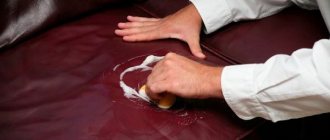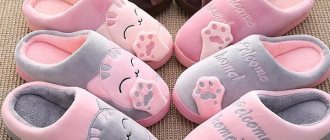What you need to know about caring for knitwear
The appearance of a new knitwear item in the wardrobe cannot but please both men and women. Even not very fussy children love these soft and comfortable clothes. During the purchase, the sellers promise us that the item will last a long time, will not stretch, will not fade, and will not be deformed. When this all happens after the first few washes, disappointment knows no bounds - you were deceived, poor quality, wasted money. In fact, the person who is to blame for the fact that knitwear quickly loses its appearance is most often not an unscrupulous seller, but a buyer who does not know the basic rules of caring for knitwear.
Reading the label
For many, it will be a “discovery” that manufacturers sew in labels not so that they get in the way and need to be cut off. On this small piece of fabric, the manufacturer places a lot of useful information on caring for the item. If the label says that the item can only be washed at 40 degrees, you should not blame the manufacturer if the clothes stretch or lose their brightness if you wash them in boiling water.
The label is the same instruction manual, so why do we read it for a new phone, but not for a new blouse? After all, the one who sewed this thing is interested in it being worn for a long time, and did everything for this.
How to wash knitwear correctly?
Nowadays, when every apartment has an automatic washing machine, such a recommendation may sound strange, but it is better to wash knitwear by hand at least at first, when the new thing is so pleasing, and has not yet managed to become an everyday item. Hand washing knitwear eliminates strong friction of the fabric. It is better to soak the contaminated item in warm, not hot, water for half an hour and then lightly wash it with the addition of a special detergent.
If hand washing is excluded, then you can use an automatic machine. All modern models have a hand wash or wash mode for delicate fabrics. For knitwear you need to use it, and a special product, preferably liquid, which makes the fabric soft and pleasant.
Knitwear cannot be wrung out or dried in a washing machine. This is a sure way to make your favorite sweater or dress two sizes larger. It is also not recommended to twist it by hand. Lightly squeeze out the water and let it drain. And the clothes will never lose their shape.
Summarizing all of the above, we can highlight several main points:
- The first stage of washing is sorting things by color: whites separately, colored ones separately;
- Knitwear is washed inside out, so you need to remember to turn things inside out;
- Knitwear cannot be washed either by hand or in a machine in water whose temperature exceeds 40 degrees;
- You should not soak knitted items for longer than half an hour;
- Thin and delicate knitwear is recommended to be machine washed only in a special bag;
- It is recommended to rinse knitted clothing only in cool water;
- Maher, interlock, cashmere are fabrics that should be washed with special products for delicate materials;
- Stains come off easily from knitwear. Usually it is enough to soak the product in water with a high concentration of detergent. It is recommended to use a stain remover less often.
These rules may seem well-known and understandable, but few people adhere to them. Although following them will help preserve your wardrobe and wear your favorite things longer.
Detergents for washing knitwear
Laundry detergent
It is not recommended to use powdered detergents. They dissolve poorly, clog fibers, leave streaks and make the fabric rougher.
Knitted items are washed exclusively with gel-based products. They dissolve and rinse well, are economical, and wash gently. The gel is suitable for any delicate fabrics, but does not remove stains as well.
The best detergents for knitwear:
- Purox Color;
- Perwoll Care and Restoration 1 l;
- Frosch;
- Sonett Neutral series Concentrate 1 l;
- Barbuda with silver ions for washing delicate linen made of wool and silk 1 l;
- Royal Powder Delicate 500 g;
- Persil Gel;
- Wellery;
- Synergic;
- Domal color;
- Eared Nanny;
- Ariel.
You can prepare the gel at home. The product is environmentally friendly, does not contain surfactants, and is safe. You can also wash children's clothes with homemade liquid gel.
- Take 200 grams of soda and soap, 3 liters of water.
- The soap is grated and melted.
- Then add soda and stir. It is important that it dissolves completely, otherwise things will be in streaks.
- The prepared mass is left for a day, poured into containers, and used if necessary. To wash colored clothes, add 1 tsp to the homemade gel. fine salt.
How to dry knitwear?
You can dry knitwear only in a horizontal position. Under no circumstances should a wet item be hung on a clothesline immediately after washing. This will cause the product to stretch and become deformed. As a result, it will be unwearable.
The easiest way to dry knitted items is on a towel. You need to lay your favorite blouse on it and replace the towel with a dry one when it gains moisture. Ideally, this should be done until the product dries, but you can replace it once.
Rules for different types of things
Each type of clothing has individual drying rules.
Bed linen
The place for drying bed linen can be chosen depending on the season and personal preferences . In the summer, for these purposes you can use the area near the house (if the house is private) or the balcony (if it is an apartment building). You can also dry it indoors, but it must have good ventilation.
When hanging bedding on lines, you need to straighten it along its entire length, without folding it in half or four.
There are several ways to make the drying process easier:
The dryer is a compact device that can be installed in the bathroom or kitchen.- Washing machine with drying function.
- Floor dryer . Compact and stable, it can be temporarily placed in any room of the apartment, and after drying, put away in the dressing room or corridor.
- Ceiling dryer with mechanical control or remote control. This functional device can become a harmonious addition to the interior of a bathroom or balcony.
- "Intelligent" dryer . Can be either wall or ceiling. Controlled remotely via remote control. Its functions include folding and unfolding, adjusting a comfortable height, as well as blowing warm air over the laundry for faster drying. The downside of this ergonomic design is the high price.
When drying bed linen, you need to follow the recommendations that will extend its service life:
- keep silk products away from heating devices;
- cotton should not be dried until completely dry to make ironing easier;
- Linen in dark and colored colors should not be dried in direct sunlight.
Underwear
You can only dry your underwear outside if you live outside the city, where there is always clean, fresh air. In a metropolis with an abundance of exhaust gases, it is best to dry these delicate clothes in contact with the surface of the body in an apartment.
There are several rules:
The room in which underwear is dried should be well ventilated and protected from direct sunlight.- Silk and viscose items should be dried away from heat sources.
- Cotton linen can be hung on a line after being shaken and straightened.
- It is recommended to dry silk and synthetic items laid out on a thick terry towel.
- It is recommended to dry bras on a horizontal surface. First you need to straighten the cups so that they maintain the correct shape.
Shirts and blouses
Shirts and blouses, regardless of the material, can be dried on hangers or hung by the hem from a rope.
If there are no free hangers or clothespins left, you should hang the product on a rope at armpit level so that there are no noticeable creases.
Pantyhose and stockings
Tights and stockings made of elastic materials should be squeezed through a piece of fabric without twisting, straightened and hung by the toes.
T-shirts
It is incorrect to hang knitted T-shirts on a rope by the bottom edge. This leads to deformation of the product - over time it takes on the shape of a trapezoid.
It is recommended to dry in one of two ways:
- Throw the upper part of the T-shirt over the rope at armpit level and secure it with clothespins at the seams of the sleeves. A wet product will not stretch and will retain its shape.
- Use a wide hanger to avoid clothespin marks.
Outerwear
Outerwear made of thick fabrics should be dried by hanging them evenly on hangers. Before doing this, blot off excess moisture with a clean cloth. While drying, the sleeves of the product should be stuffed with crumpled paper.
Ironing knitwear
This procedure also contains soy secrets. Iron knitwear only from the inside out, almost without touching the surface with the iron. If there is a need to smooth out frills or frills on the front side, be sure to use a damp cloth or material.
But knitwear’s best friend is a steam generator, which will help keep knitwear in its original form for a very long time.
Decorative items made of leather or fur cannot be washed or ironed at home. Clothing with such decorations should be dry cleaned.
Bleaching knitwear
To maintain the normal appearance and quality of the product, you must follow some rules for washing and bleaching the material. It is important to use only approved products and not experiment, so as not to get disastrous results.
Products for bleaching knitted items:
- One of the most gentle and effective methods of whitening is German salt for stains Sil. Valid at 20°C. Active oxygen removes stains from fruits, red wine, coffee, lipstick. Directions for use: dissolve 50 g of powder in 4 liters. Place the laundry and stir. Leave overnight. Rinse.
- Wet the clothes with water and rub with 72% laundry soap to create a rich, dense foam. Leave to soak for 20 minutes. Water temperature 30-40 °C. Rinse things several times.
- Resuscitate with ammonia. Mix a bottle of ammonia with 10 liters of water at a temperature of 20-30 °C. Place the faded knitted item in the solution for 10 minutes. Wash, rinse twice.
- Use Vanish for white, but with caution. Using a measuring spoon, apply the gel to the stain and rub in with the dispenser. Leave for 10-15 minutes. For soaking, add 100 ml of Vanish to 4 liters of water, water at a temperature of 20-40 °C. Soak for no more than 30 minutes.
- Amway is a universal bleach for all types of fabrics. Dissolve the liquid product in hot water, add cold water until the temperature reaches 30 °C. Soak dirty knitwear overnight. Wash as usual, rinse well.
- With the help of mustard powder you can rid knitwear of grayness and stains. 4 tbsp. Dilute the product in 1 liter of hot water and wait until dissolved. Add cold water so that the temperature is no more than 40 °C. Place the product in the solution, wash after 30 minutes and rinse twice.
ARTICLE FOR YOU
How to wash: leather, eco-leather, leatherette
For severe stains, when home whitening does not help, seek professional help. In-salon dry cleaning will remove any stains without damaging the fibers of the material.
Combating the main problem of knitwear – pilling
These unpleasant, unaesthetic and unsightly lumps of lint form on the surface of the material as a result of improper care. Another reason for this rolling may be friction. Often, pellets form on the elbows, in places where a bag or other accessories rub against clothing. It is difficult to combat this phenomenon, but it is possible.
In the “civilized world” they came up with special machines to combat pellets. But our women are not looking for easy ways, so to combat this problem, a variety of means are used - tape, toothpicks and even razors.
Knitted clothing can give a lot of pleasant moments in comfort and aesthetics, but in return it requires careful care and attention. The simple recommendations outlined above will give your clothes longevity.











